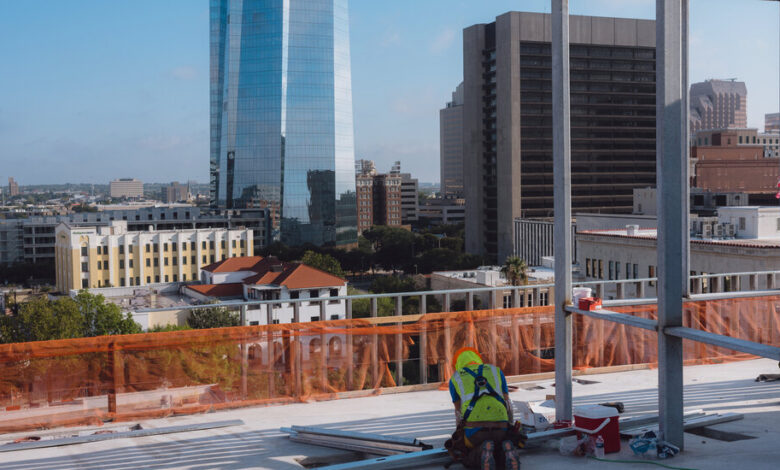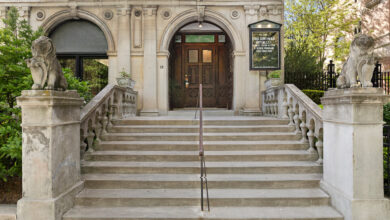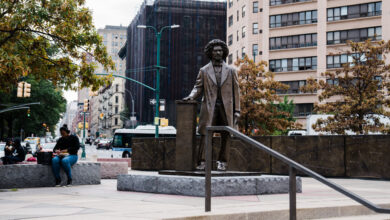San Antonio’s Challenge: Balancing Growth With Heritage

[ad_1]
When the 23-story Frost Tower opened in downtown San Antonio in 2019, the eight-sided pinwheel of glass represented a resurgent decade of downtown development. It was the city’s first new office tower in three decades.
For Randy Smith, chief executive of Weston Urban, one of the developers behind the project, it was the beginning of a new wave of activity. Now that the offices have arrived downtown, a new flood of residents comes next.
One of the firm’s next big projects, a 32-story brick residential tower a few blocks away, is breaking ground this year. “The Frost Tower is this great, big visible symbol of a new era of downtown,” Mr. Smith said. “And the residential tower will be the same thing.”
But community advocates are pushing back against some of this growth, saying the new office and apartment towers are encroaching on the city’s historic neighborhoods that have formed a cultural core of Mexican American heritage.
“San Antonio has a wonderfully preserved historic downtown, an historic building stock and the River Walk, and that’s the image the city projects to the world,” said Ian Caine, the director of the Center for Urban and Regional Planning Research at the University of Texas at San Antonio. “And then on the other hand, it’s one of the fastest-growing cities in the U.S., famously bicultural and minority-majority, and one of the most segregated and poor cities in the U.S.”
“As San Antonio moves forward, it’s trying to make sense of these competing histories,” he added.
Often overlooked compared with Texas’ other major cities, San Antonio has been one of the fastest-growing metro regions in the United States for years. Its population grew 8.1 percent in the last decade, with predictions that it will welcome a million more by 2040. Developers are moving at a similarly brisk pace.
A number of large-scale projects will bolster recent growth downtown. The $700 million Lone Star District should break ground this year; Essex Modern City, a $150 million multiuse district, finally cleared funding and regulatory hurdles; and the second phase of redevelopment within Hemisfair Park will break ground this fall. Other notable projects include a mass-timber office tower called the Soto, a $450 million renovation of the historic Alamo Plaza, and the development of new parks and green space along the San Pedro Creek.
“San Antonio is still flying under the radar and, in my opinion, the best-kept secret in the U.S.,” said Jake Harris, a managing partner at Harris Bay, a developer based in Sacramento that is behind numerous projects in San Antonio, including Essex Modern City. “The growth isn’t priced into real estate yet, and you can still get a good deal as institutional capital starts coming in.”
The nexus tying these threads together may be the significant expansion of the downtown campus of the University of Texas at San Antonio, which held a virtual groundbreaking in January. Expected to draw 15,000 additional students over the next decade, the university is adding streetscapes and academic facilities, including the $90 million School of Data Science and National Security Collaboration Center, to supercharge growth in industries of the future.
The ability to develop this site feels like the creation of a “complete district,” said Corrina Green, associate vice president for real estate, construction and planning at the university.
The expansion has the potential to be an incubator for development, but it is also likely to catalyze further commercial and residential development downtown, worrying some community groups.
In recent decades, San Antonio’s relatively small, walkable downtown — due in part to streets that trace the path of Spanish colonial-era irrigation canals called acequias — has been outpaced by suburban growth and development. Even now, the more high-income suburbs offer 26.4 million square feet of office space, versus 4.9 million downtown.
Early projects pointed to the area’s potential, especially the redevelopment of a brewery by Christopher Goldsbury, a former Pace Foods chief executive, that became the Pearl District, an entertainment destination. But investment started to grow substantially in 2010, when former Mayor Julián Castro started the Decade of Downtown initiative.
That shifted the traditional calculus of building downtown, said Kamil Alavi, partner at GrayStreet Partners, which is developing the Lone Star site. Projects requiring demolition and replacement of old buildings were not cost effective, nor were some with undeveloped lots, although these limits encouraged adaptive reuse that has accentuated the city’s architectural heritage.
Now, there are more opportunities, with 2.4 million square feet of real estate under construction downtown, said Ryan Metz, a brokerage adviser at ECR.
“There’s a mismatch, between the demand for real estate and what’s currently downtown, that won’t be met anytime soon,” Mr. Alavi said.
That demand, and the need for new housing, has worried advocates and community members in the Westside, a neighborhood of small stores, or tienditas, and tightly knit single-family homes that is a wellspring of affordable homeownership for low- to medium-income residents, with homes often passed down through generations.
“This is where people have lived for generations, where the Chicano movement started, and there’s so much rich history,” said Levar Martin, chief program officer of the National Association for Latino Community Asset Builders, which is based in San Antonio. “It’s not just about preserving the housing stock. It’s about people’s culture and life.”
The Esperanza Peace and Justice Center has pushed for affordable housing and recognition of historic architecture and is restoring 11 historic “casita” homes and buildings and constructing a museum highlighting the history of the Westside, to create the Rinconcito de Esperanza, a historic cultural district.
The Decade of Downtown initiative invested in housing for new arrivals, but not those who had lived downtown for generations, said Graciela Sanchez, the center’s director.
“This neighborhood is the Ellis Island of Mexican Americans,” she said, and she has battled to protect it, joining community protests last year against the plans to demolish and rebuild the Alazán-Apache Courts, a historic public housing project.
City and housing officials are grappling with what comes next, especially when it comes to access and affordability. Previous development focused more on increasing the total number of downtown homes, said Mia Loseff, a policy analyst for Texas Housers, a nonprofit organization focused on low-income housing. New policy and incentives need to be more attuned to encouraging housing for every income level, and realizing “the most affordable housing is the structures we already have,” she said.
Half of San Antonio’s affordable housing is not subsidized, thus more subject to market forces. Groups like the Esperanza Peace and Justice Center and others have promoted the development of land trusts as well as targeted investments to help homeowners.
Mayor Ron Nirenberg and his administration have created means to invest in housing, including setting aside funding for affordable housing and establishing a $1 million risk mitigation fund in 2019 to help residents displaced by development, which will receive $4 million in additional funds this year.
The city is seeking to complete a new strategic housing plan, which includes proposals to offer incentives for private-sector development and create 28,000 units in the coming decade that will mostly support lower-income residents. And in May, the city will vote on a planned $250 million affordable housing bond measure that would fund construction, preservation and land banking.
Now is the time to figure out the right formula for preserving the city’s heritage and maintaining affordable housing, said Mr. Martin of the National Association of Latino Community Asset Builders.
“I understand the city wanting to leverage the culture, but it needs to be followed with equitable preservation for the folks who are there,” he said.
[ad_2]
Source link






